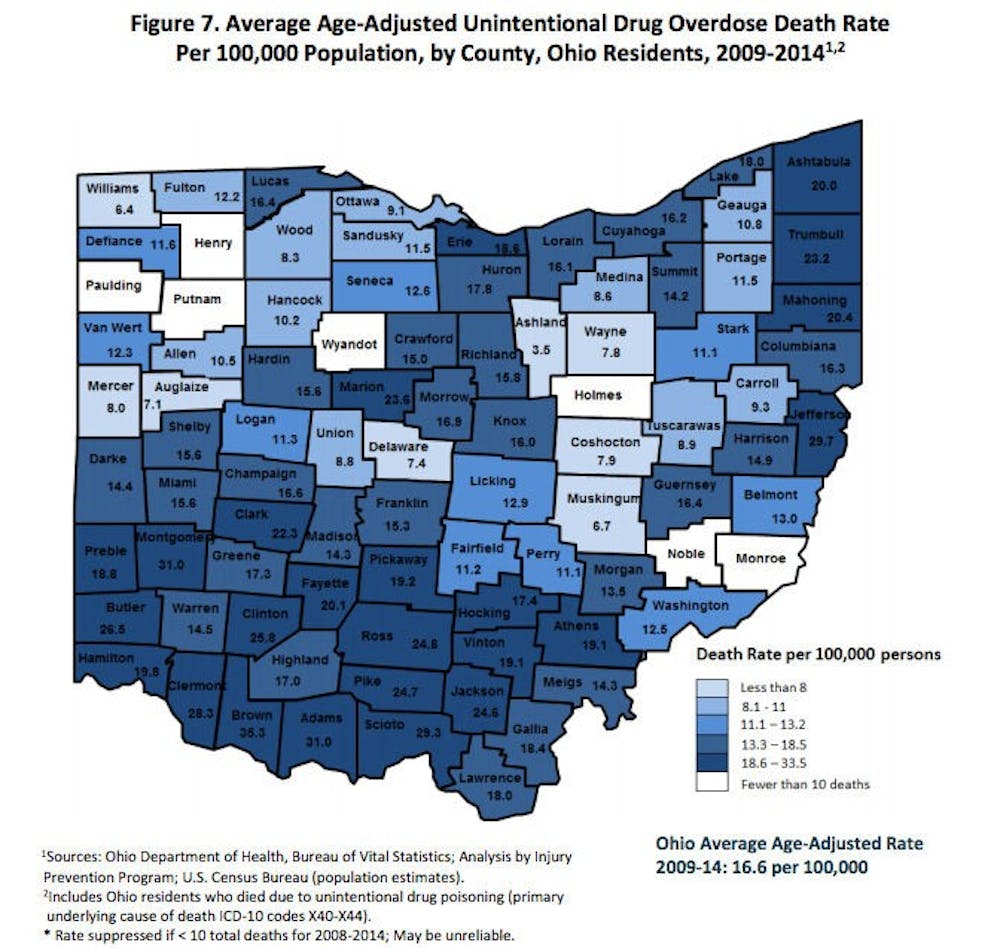Correction appended
Two years after officials introduced a new antidote for opioid overdoses, Athens County is opposing state trends for the rate of drug-related deaths.
In 2011, 14 individuals in the county died from overdosing; the highest number of deaths in the last six years. In 2015, a year after the life saving drug naloxone (known as Narcan) made its way into the county, there was about a 57 percent decrease in those deaths compared to 2011.
“I’d like to attribute that to the fact that in 2014, we began giving out packets of Narcan," James Gaskell, the Athens city-county health commissioner, said.
Two years ago, the Athens City-County Health Department joined the state-administered DAWN (Deaths Avoided With Naloxone) program, which uses the nasal-administered treatment to stop opiate overdoses.
According to 2015 data from the Ohio Department of Health, drug overdoses in the state increased 20.5 percent from 2014 to 2015, from 2,531 to 3,050. The state saw a similar increase from 2013 to 2014.
The drug knocks the opioids out of the respiratory center of the brain, giving the individual the ability to breathe, which in turn gives that person time to receive care from a hospital.
The kits — and the training to administer the drug — have remained free to people who think they’ll need it to save a family member or friend, Gaskell said.
Since the start of the program, Gaskell’s department has provided 68 DAWN kits to individuals in Athens County.
While those individuals haven't come in for kit refills, he said the decrease in overdoses likely means they are using those kits.
Gaskell said he believes people don’t report the “saves” due to fear of law enforcement stepping in and arresting them.
The health department does not report those who seek the kits to local law enforcement, he added. Local law enforcement officers have also said they would rather save someone’s life than arrest them for drug activity.
“We’ve trained the sheriff deputies, the city police and (Ohio University) police in Narcan,” Gaskell said. “They are all armed with Narcan to facilitate rescues.”
The Athens Sheriff’s office was the first to pledge to install the DAWN kits in its cruisers, according to a previous Post report. Since then, the deputies have used it twice to save lives, Sheriff Rodney Smith said, with one save occurring on Christmas Eve, according to a previous Post report.
Shallow breathing and black fingernails are the usual signs of an overdose, Smith said. Once deputies administer naloxone, the individuals begin taking deeper breaths.
After reluctance to put the DAWN kits in its cruisers, Athens Police Department Chief Tom Pyle said he’s glad his department uses the kits.
When the kits were first available, Pyle said opiates had not “infiltrated” the city, adding that his department primarily saw "designer party drugs."
“We have seen recently, in the last 12 months, that opiates are starting to creep in a lot more, even in student culture,” Pyle said.
Although APD has seen an increase in opiate use in the city, the number of overdoses recorded by the Athens County coroner has continued to decrease. Only three have been recorded so far this year.
The process to determine if an individual has overdosed varies on a case-by-case basis, Carl Ortman, Athens County coroner, said.
The team of investigators at the coroner's office are on call 24/7, meaning they inspect bodies whenever the deceased is found, which could range from 12 hours to 12 days after the death, Ortman said.
Those differences in time affect the physical exam, he said.
“People aren’t usually discovered in the middle of the night,” Ortman said. “They’re discovered when their spouse wakes up in the morning, and then in the late afternoon, you know, people get home from work and see this.”
When the exam does take place, physical signs of an overdose include foam mixed with discharge around the mouth and track marks from previous opioid injections, Ortman said.
“If it’s been 12 days, you’re looking at a very, very different body,” Ortman said.
That’s when some form of an autopsy is helpful to determine the cause of death, and it doesn’t have to be surgical, Ortman said. A urine or blood sample can show chemical traces of opioids in the deceased body.
It is not always heroin that causes the overdose, Ortman added.
"In my mind as a physician, you’re looking at the same kind of drug — heroin that was bought off the street or pain medications that were bought off the street or wherever they’re obtained," he said. "You’re dealing with similar substances that have the same effect on the body."
Correction: A previous version of this article incorrectly stated which year was the highest for opioid overdoses. Most recently, the highest number of deaths was in 2011. Additionally, the article has been updated to clarify that the 57 percent decrease in those deaths is compared to 2011. The article has been updated to show the most accurate information.





